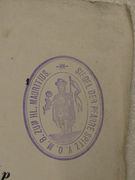An exciting collection
Gottfried Heinz-Kronberger
Monday, June 20, 2016

The following article has reached us from Gottfried Heinz-Kronberger of RISM Germany:
The music collection from Spitz an der Donau in Austria is preserved in the archives of the Benedictine Abbey Niederaltaich (D-NATk) in southeast Germany. This arrangement has a historical reason. Niederaltaich Abbey, which was founded in 741, stretched its circle of influence along the Danube River into the Wachau region of Austria (where Spitz is located) in the course of Carolingian rule. In a letter dated 6 October 830 Louis the German confirms a gift of the region around Spitz to the abbey. The Spitz provost district was then in possession of Niederaltaich Abbey until secularization in 1803. For a closer examination, see Erich Schöner’s two-volume Geschichte des Marktes Spitz a. d. Donau (1979). Niederaltaich Abbey was not reestablished until 1918.
The music collection consists mostly of manuscripts, with a small number of printed items. For the most part, the prints can be dated later than the manuscripts. Prints (or other manuscripts) used to be copied rather than bought, which had to do with the costs of new prints, which were relatively high - or to put it another way, a copyist was more affordable. To enable a complete presentation of the collection, the manuscripts as well as the prints were compiled into a catalog, making it easier to get an overview.
Of the 630 RISM records, 562 are for manuscripts and 68 are prints. The oldest manuscripts are from the last quarter of the eighteenth century. All of the music - manuscripts and prints - was included in this new cataloging phase to enable a presentation of the entire collection in a clear and complete way.
Some items deserve special mention for their noteworthiness. First and foremost are manuscripts by Michael Haydn that are mainly known from the music catalog of Göttweig Abbey (numbers 1207, 1221, and 2239). There, the “Cantate Domino” (MH 97 in Charles H. Sherman’s thematic catalog) is listed but with no extant copies; the one in Spitz with the shelfmark NA/SP (H-32) is therefore completely unique (RISM ID no. 455039951). Of the second part of the “Civitatem. Festina lente” (MH 47) using the text “Ut tibi dulces fuerunt lapides”, there is only one further copy in Hungary (Spitz copy: shelfmark NA/SP (H-60), RISM ID no. 455039981). These one-of-a-kind manuscripts share space in the Spitz collection with no less interesting works that are allegedly by Michael Haydn, such as a “Regina caeli” in C major with the shelfmark NA/SP (72), in Sherman’s catalog (MH 128) listed as being in D major, but which is actually probably by Joseph Krottendorfer (1741-1798) based on numerous concordant manuscripts. Likewise, the gradual “Inveni David,” which is attributed to a Haydn (shelfmark NA/SP (H-52)) was composed by Johann Georg Albrechtsberger.
In addition to all these there are also works that are still cloaked in anonymity but nevertheless look musically interesting. Worthy of a closer look is a passion cantata (shelfmark: NA/SP (A-44), RISM ID no.: 455039755) that is by a composer who is still anonymous and whose texts are borrowed from Barthold Heinrich Brockes in some parts and taken from Bach’s St. John Passion in others.
In numerous older folders, performance dates have been written in. They document intensive use of the music. Any conclusions as to how the music came into existence can only be inferred in a limited way by treating the dates as a terminus ante quem, since many manuscripts were certainly written a lot earlier. The performances date from 1828 (NA/SP (S-55)) to 1911 (NA/SP (H-18) and (H-88)).
All in all, the collection represents a unit that one rarely comes across these days. It was probably about 25% bigger than it is today, which one can gather from loose, individual pages. Despite the losses, one still gains insight into music-making practices from the time. To increase our knowledge, one could do more research on the copyists, or any kind of biographical research about individuals from the Spitz parish, especially the teachers, who often had music-related duties. The references to the pieces that are only indexed in the Göttweig catalog make these manuscripts from Spitz a special rarity and the connection to Göttweig Abbey - hardly more than 20 km away - is obvious, but also still requires more research.
Share Tweet EmailCategory: Rediscovered

